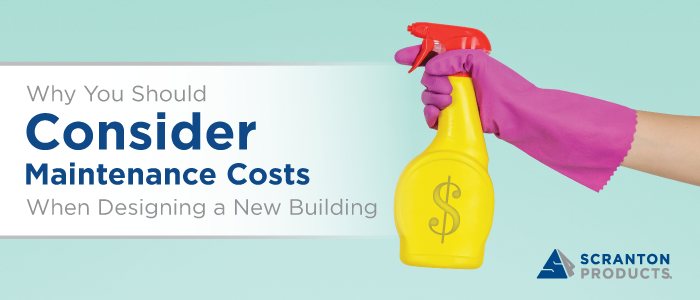Why You Should Consider Maintenance Costs When Designing a New Building
It’s easy to overlook maintenance costs when designing a new building, but it could end up hurting you. That’s because administrators, contractors, architects, and other building officials are under constant pressure to keep costs down and stay within budget. However, choosing the cheapest materials or building methods can have expensive maintenance requirements.
In this post, we take a closer look at why it’s important to consider maintenance costs when designing a new building as well as the difference between initial cost and life cycle cost.
Understanding Initial Cost and Life Cycle Cost
When you create a budget for a new building design, you’re looking at the initial cost. The budget specifies how much of the allocated funds will be used for each component, including supplies and labor. Although it’s true that every project relies on this number for approval, shooting for the lowest initial cost isn’t always the best decision.
For example, when purchasing building materials, the least expensive option might be of the poorest quality. In most circumstances, you pay more for higher quality and longer material life span.
Life cycle cost, on the other hand, is a way of budgeting that considers the entire cost of a material over the course of its life span. This includes any anticipated repairs, replacements, or maintenance. For example, let’s say one lamp cost $100 and another cost $200. The first lamp is cheaper, but the life expectancy of the second lamp is three times as long.
Thus, you’d spend more money in the long run by purchasing the $100 lamp since you’d have to replace it twice before you’d need to replace the more expensive lamp.
Calculating Maintenance Costs
Now that you’ve learned the difference between initial and life cycle costs, it’s easy to see why buying for life cycle costs is the smarter choice. But how exactly do you know if a material or building method will help to lower maintenance costs? Here are a few ways to help you make the right decision.
Is It Easy to Clean?
Clean materials tend to outlast those that aren’t, so opting for materials and products that are easy to clean and care for is a great idea. But not only might the material last long, it could also save you money on cleaning costs since less cleaning materials will need to be used.
Does It Resist Damage?
Being durable is a good sign that the product or material is going to help cut your long-term maintenance costs. The good news is, products that are resistant to damage like dents, scratches, or graffiti will usually showcase that aspect as one of the primary features of the product. If you’re not sure, talk with your architect or contractor.
What Kind of Regular Care Does It Need?
Lights will need to have their bulbs replaced, HVAC systems will require routine maintenance, but it’s important to know these things before you make a purchase and factor that into the life cycle cost. For example, HDPE bathroom partitions are colored throughout and don’t require painting or repainting, whereas metal partitions do.
As you can see, it’s vital for you to consider maintenance costs when designing a new building. Follow these tips and you’ll be on your way to building a cost-effective facility.




